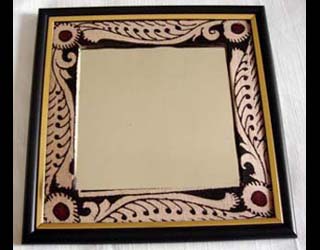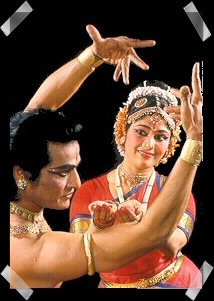 |
| Kalamkari painting |
 |
| Mirror with Kalamkari frame: DWARAKA |
Kalamkari has of late caught my fancy. I have started my collection with
a bag from Fabindia. And then rediscovered two gorgeous Kalamkari
pieces of textiles that I had bought from Mahua Sarkar Sen.She works with Kalamkari Gurus & Award winners. My quest finally led me to some more designers who are rediscovering and propagating this art form.
The word Kalamkari or Qalamkari has been derived
from the Persian words kalam(pen) and kari(craftsmanship), meaning
drawing with a pen. It involves hand painting as well as block printing with vegetable dyes.
Kalamkari art has evolved over the last 3000 years mainly in two villages of Andhra Pradesh-- Srikalahasti, 80 miles north of Chennai
near Tirupati and Masulipatnam, 200 miles east of Hyderabad.
Both
centers have a distinct style of Kalamkari. The art evolved under the patronage of the Mughals
and Golconda Sultanate. There are two styles of Kalamkari -- Srikalahasti
and Machilipatnam.
Via
In Srikalahasti,
artists make free-style drawings and fill them with natural dyes. Traditionally, this type of
paintings were found on the scrolls, temple hangings and chariot banners and
the themes constituted mythological figures. But now kalamkari can be found
on saris, tunics, lampshades, bags etc. Smt Kamaladevi Chattopadhay, the first Chairperson of All India Handicrafts Board, popularised this art to the present
form.
There are
seventeen painstaking steps of dyeing in Kalamkari. In ancient times, groups of singers, musicians and painters,
called chitrakattis, moved village to village to depict the great stories of Hindu
Mythology.
Here are
some more beautiful kalamkari works and a few designers who are working towards
popularising it.
Angikam by Kuchipudi dancer Banasri Rao
Renowned Kuchipudi dancer Banasri or Vanashree Rao was often complimented for her designer blouses and exquisite saris. This prompted her to launch her label Angikam to propagate the Kalamkari art.
A Padmashri recipient for her contribution to Kuchipudi dance form, Banasri's Kalamkari
designs are a unique blend of classic and contemporary styles. During her frequent
visits to Tirupati, she was introduced to the traditional craft of block and
hand painting, which eventually prompted her to create her own
designs.
"I put my aesthetic sense to use," Banasri, a former
lecturer of philosophy, claims. She says that feeling beautiful is of utmost
importance for her, and she hopes that her collection will have a similar effect
on her customers.
Her concept blouses and dupattas are being sold at
Kamala (Crafts Council of India’s store), Kolkata, and Paddakam, at
Santusti, Delhi.
Banasri also gives new life to old saris by combining two or more saris a client may give her, and,creates a new sari with appliqué work
and embroidery.
 |
| Banasri in her creation: India Today |
 |
| A Kalamkari Blouse: Telegraph |
 |
| Banasri and her dancer husband Jayarama Rao |
 |
| The couple performing on stage |
Via
Mora by ex-media professional Ritika Mittal
 |
| Ritika Mittal of Mora |
This how Mora describes itself: From the mesmerisingly
delicate wiles of Naga Eri silk to the intricate playfulness of Maharashtrian
Warli, bordered and splashed with the voluptuous bold beauty of Andhra
Kalamkari, all of Mora’s textile creations are a jigsaw
puzzle of all-natural motifs, colours and textures from the remotest corners of
India: a contemporary ode to the magical contradictions and mind-boggling
variety of the country’s ancient art.
Brainchild of Ritika Mittal, who wanted a break from her hectic schedule as a Supervising Producer for a television channel and was looking for something unique non-bling stuff for her own trousseau,
Each Mora piece is one-of-a-kind. Here are some kalamkari pieces from Mora. They have many more in their treasure trove.
Via
Mora on Facebook
Asmita Marwah
 |
| Asmita Marwah |
 |
| Asmita Marwah |
 |
| Asmita Marwah |
Sasikant Naidu
 |
| By Sashikant Naidu |




























Nice Pics, keep updating
ReplyDelete